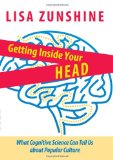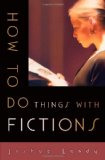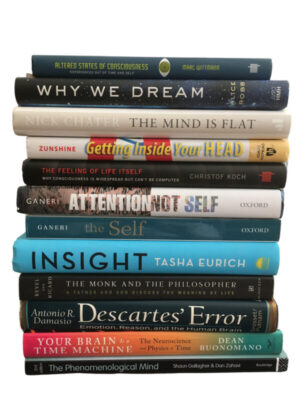August 4, 2012

Getting Inside Your Head: What Cognitive Science Can Tell Us about Popular Culture by Lisa Zunshine (Johns Hopkins University Press, 2012)
(kindle ed.), (amazon.co.uk)
Book description from the publisher:
We live in other people’s heads: avidly, reluctantly, consciously, unaware, mistakenly, and inescapably. Our social life is a constant negotiation among what we think we know about each other’s thoughts and feelings, what we want each other to think we know, and what we would dearly love to know but don’t.
Cognitive scientists have a special term for the evolved cognitive adaptation that makes us attribute mental states to other people through observation of their body language; they call it theory of mind. Getting Inside Your Head uses research in theory of mind to look at movies, musicals, novels, classic Chinese opera, stand-up comedy, mock-documentaries, photography, and reality television. It follows Pride and Prejudice’s Mr. Darcy as he tries to conceal his anger, Tyler Durden as he lectures a stranger at gunpoint in Fight Club, and Ingrid Bergman as she fakes interest in horse races in Notorious.
This engaging book exemplifies the new interdisciplinary field of cognitive cultural studies, demonstrating that collaboration between cognitive science and cultural studies is both exciting and productive.
Google Books preview:
See also: Author’s website
Comments (1)
- cognitive science,culture,fiction
July 21, 2012

What Are You Laughing At?: A Comprehensive Guide to the Comedic Event by Dan O’Shannon (Continuum, 2012)
(amazon.co.uk)
Book description from the publisher:
If you’re looking for a book that will teach you how to write comedy, we suggest you keep moving. You still have time to pick up a copy of Writing Big Yucks for Big Bucks before the store closes. However, if you want to understand the bigger picture — what is comedy, why do we respond to it the way we do — then you’ve come to the right place.
What Are You Laughing At? presents an entirely new approach to comedy theory. It challenges long-held beliefs and shows how the three main theories of comedy (incongruity, superiority, and relief) are not in conflict; but rather, work as parts of a larger model. There are many examples pulled from the author’s own experiences, writing for shows such as Cheers, Frasier, and Modern Family. By the end, you’ll have an understanding of just what happens when man meets comedy. It will change the way you hear laughter.
Table of Contents
INTRODUCTION
OVERVIEW
Common Comedy Theories
The Comedic Event
Documenting the Comedic Event
PART I: ELEMENTS OF CONTEXT: THE RECEPTION FACTORS
CHAPTER 1: THE RECEIVER AND HIS WORLD
1-1. A Comedy Frame of Mind
1-2. Early Reception Factors
1-3. Levels of Social Interaction
CHAPTER 2: ELEMENTS OF COMMUNICATION
2-1. Modes of Communication
2-2. Device and Specific Device
CHAPTER 3: VEHICLES
3-1. Vehicles
3-2. Vehicle-based Reception Factors
CHAPTER 4: LEVEL OF CONTROL AND IDENTIFYING THE SOURCE
4-1. Level of Control
4-2. Identifying The Source
PART II: THE INCONGRUOUS PICTURE
CHAPTER 5: FUNDAMENTAL COMPONENTS
5-1. The Receiver’s Brain: Hard-wired for Comedy?
5-2. The Triangle
5-3. The Core Variables
CHAPTER 6: INCONGRUITY
6-1. Incongruity
6-2. Estimating Levels of Incongruity
6-3. Types of Incongruity
CHAPTER 7: COGNITIVE PROCESS
7-1. Cognitive Process: Overview
7-2. Level One: Straightforward Information
7-3. Level Two: Gap-filling
7-4: Level Three: Recontextualization
CHAPTER 8: VARIATIONS
8-1. Exploring the Four Corners of the Triangle
8-2. What are Practical Jokes?
CHAPTER 9: COMEDY AND ENTROPY
9-1. Sustaining the Laugh
9-2. Entropy
PART III: ENHANCERS AND INHIBITORS
CHAPTER 10: HOW COMEDIC INFORMATION TRIGGERS ENHANCERS AND INHIBITORS
10-1. Overview
10-2. On-going Social Needs: Superiority, Identification, and Inclusion
10-3. Aspects of Awareness
CHAPTER 11: ELEMENTS OF THE JOKE’S COMMUNICATION, STRUCTURE, AND CONTENT
11-1. Resuming the Chart: The Joke as a Whole
11-2. Elements of Communication and Structure
11-3. Elements of Content
SUMMING IT ALL UP
The Completed Chart
Final Thoughts and Acknowledgments
Comments (0)
- fiction,new books,psychology
July 6, 2012

How to Do Things with Fictions by Joshua Landy (Oxford University Press, USA, 2012)
(amazon.co.uk – July 2012)
Book description from the publisher:
Why does Mark’s Jesus speak in parables? Why does Plato’s Socrates make bad arguments? Why are Beckett’s novels so inscrutable? And why don’t stage magicians even pretend to summon spirits anymore? In a series of captivating chapters on Mark, Plato, Beckett, Mallarmé, and Chaucer, Joshua Landy not only answers these questions but explains why they are worth asking in the first place.
Witty and approachable, How to Do Things with Fictions challenges the widespread assumption that literary texts must be informative or morally improving in order to be of any real benefit. It reveals that authors are sometimes best thought of not as entertainers or as educators but as personal trainers of the brain, putting their willing readers through exercises designed to fortify specific mental capacities, from form-giving to equanimity, from reason to faith.
Delivering plenty of surprises along the way-that moral readings of literature can be positively dangerous; that the parables were deliberately designed to be misunderstood; that Plato knowingly sets his main character up for a fall; that metaphor is powerfully connected to religious faith; that we can sustain our beliefs even when we suspect them to be illusions-How to Do Things with Fictions convincingly shows that our best allies in the struggle for more rigorous thinking, deeper faith, richer experience, and greater peace of mind may well be the imaginative writings sitting on our shelves.
See also: article “Fiction books give a boost to the brain, says Stanford professor”
Comments (0)
- fiction,new books,psychology,reading
June 30, 2012

Thinking without Thinking in the Victorian Novel by Vanessa L. Ryan (Johns Hopkins University Press, 2012)
(amazon.co.uk)
Product description from the publisher:
In Thinking without Thinking in the Victorian Novel, Vanessa L. Ryan demonstrates how both the form and the experience of reading novels played an important role in ongoing debates about the nature of consciousness during the Victorian era.
Revolutionary developments in science during the mid- and late nineteenth century—including the discoveries and writings of Herbert Spencer, William Carpenter, and George Henry Lewes—had a vital impact on fiction writers of the time. Wilkie Collins, George Eliot, George Meredith, and Henry James read contributions in what we now call cognitive science that asked, “what is the mind?” These Victorian fiction writers took a crucial step, asking how we experience our minds, how that experience relates to our behavior and questions of responsibility, how we can gain control over our mental reflexes, and finally how fiction plays a special role in understanding and training our minds.
Victorian fiction writers focus not only on the question of how the mind works but also on how it seems to work and how we ought to make it work. Ryan shows how the novelistic emphasis on dynamic processes and functions—on the activity of the mind, rather than its structure or essence—can also be seen in some of the most exciting and comprehensive scientific revisions of the understanding of “thinking” in the Victorian period. This book studies the way in which the mind in the nineteenth-century view is embedded not just in the body but also in behavior, in social structures, and finally in fiction.
Comments (0)
- cognitive science,consciousness,culture,fiction,new books
April 10, 2012

The Storytelling Animal: How Stories Make Us Human by Jonathan Gottschall (Houghton Mifflin Harcourt, 2012)
(kindle ed.), (amazon.co.uk)
Humans live in landscapes of make-believe. We spin fantasies. We devour novels, films, and plays. Even sporting events and criminal trials unfold as narratives. Yet the world of story has long remained an undiscovered and unmapped country. It’s easy to say that humans are “wired” for story, but why?
In this delightful and original book, Jonathan Gottschall offers the first unified theory of storytelling. He argues that stories help us navigate life’s complex social problems — just as flight simulators prepare pilots for difficult situations. Storytelling has evolved, like other behaviors, to ensure our survival.
Drawing on the latest research in neuroscience, psychology, and evolutionary biology, Gottschall tells us what it means to be a storytelling animal. Did you know that the more absorbed you are in a story, the more it changes your behavior? That all children act out the same kinds of stories, whether they grow up in a slum or a suburb? That people who read more fiction are more empathetic?
Of course, our story instinct has a darker side. It makes us vulnerable to conspiracy theories, advertisements, and narratives about ourselves that are more “truthy” than true. National myths can also be terribly dangerous: Hitler’s ambitions were partly fueled by a story.
But as Gottschall shows in this remarkable book, stories can also change the world for the better. Most successful stories are moral—they teach us how to live, whether explicitly or implicitly, and bind us together around common values. We know we are master shapers of story. The Storytelling Animal finally reveals how stories shape us.
Google books preview (scroll down):
See also: Author’s website
Comments (0)
- culture,fiction,new books







